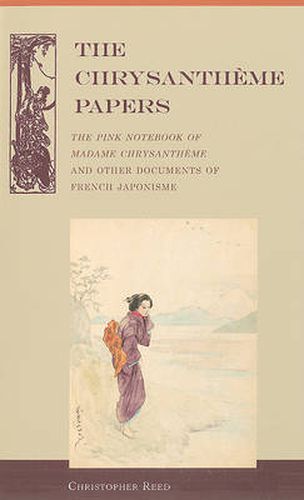Readings Newsletter
Become a Readings Member to make your shopping experience even easier.
Sign in or sign up for free!
You’re not far away from qualifying for FREE standard shipping within Australia
You’ve qualified for FREE standard shipping within Australia
The cart is loading…






Pierre Loti’s novel
Madame Chrysantheme
(1888) enjoyed great popularity during the author’s lifetime, served as a source of Puccini’s opera Madama Butterfly, and remains in print to this day as a classic in Western literature. Loti’s story describes the affair between a French naval officer and Chrysantheme, a temporary ‘bride’ purchased in Nagasaki. More broadly, Loti’s novel helped define the terms in which Occidentals perceived Japan as delicate, feminine, and, to use one of Loti’s favorite words, ‘preposterous’ - in short, ripe for exploitation. Written by Felix Regamey, a talented illustrator with firsthand knowledge of Japan,
The Pink Notebook of Madame Chrysantheme
(1893) retells Loti’s story but this time as the diary of Chrysantheme. The book, presented here in English for the first time and together with the original French text and illustrations by Regamey and others, is certainly surprising in its late nineteenth-century context. Its retelling of a classic tale from the position of a character marginalized by her sex and race provocatively anticipates certain aspects of postmodern literature. Translator Christopher Reed, whose rich and satisfying introduction provides intellectual context, includes new translations of excerpts from Loti’s novel as well as a portion of the travel journal of Regamey’s travel companion, the renowned collector Emile Guimet.
$9.00 standard shipping within Australia
FREE standard shipping within Australia for orders over $100.00
Express & International shipping calculated at checkout
Pierre Loti’s novel
Madame Chrysantheme
(1888) enjoyed great popularity during the author’s lifetime, served as a source of Puccini’s opera Madama Butterfly, and remains in print to this day as a classic in Western literature. Loti’s story describes the affair between a French naval officer and Chrysantheme, a temporary ‘bride’ purchased in Nagasaki. More broadly, Loti’s novel helped define the terms in which Occidentals perceived Japan as delicate, feminine, and, to use one of Loti’s favorite words, ‘preposterous’ - in short, ripe for exploitation. Written by Felix Regamey, a talented illustrator with firsthand knowledge of Japan,
The Pink Notebook of Madame Chrysantheme
(1893) retells Loti’s story but this time as the diary of Chrysantheme. The book, presented here in English for the first time and together with the original French text and illustrations by Regamey and others, is certainly surprising in its late nineteenth-century context. Its retelling of a classic tale from the position of a character marginalized by her sex and race provocatively anticipates certain aspects of postmodern literature. Translator Christopher Reed, whose rich and satisfying introduction provides intellectual context, includes new translations of excerpts from Loti’s novel as well as a portion of the travel journal of Regamey’s travel companion, the renowned collector Emile Guimet.